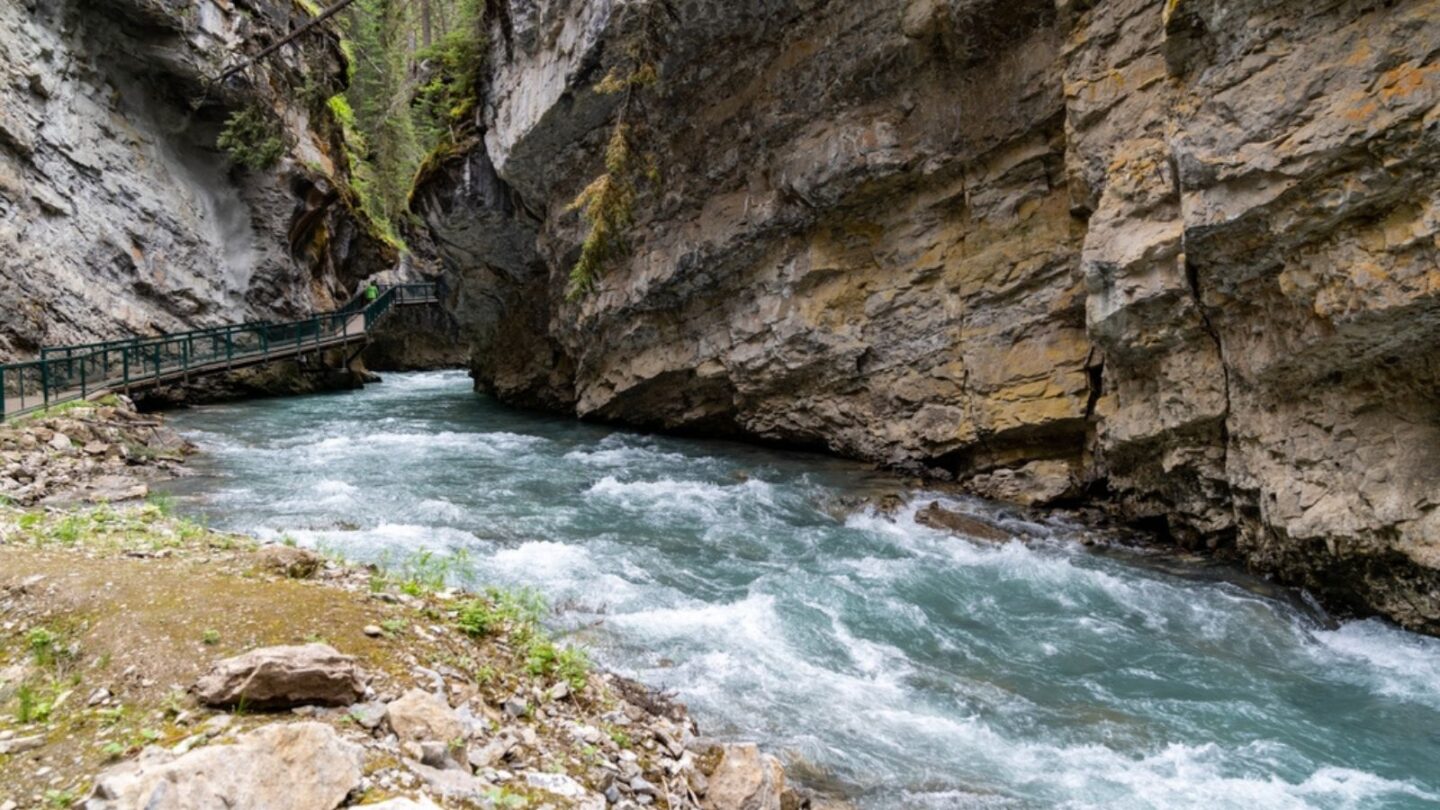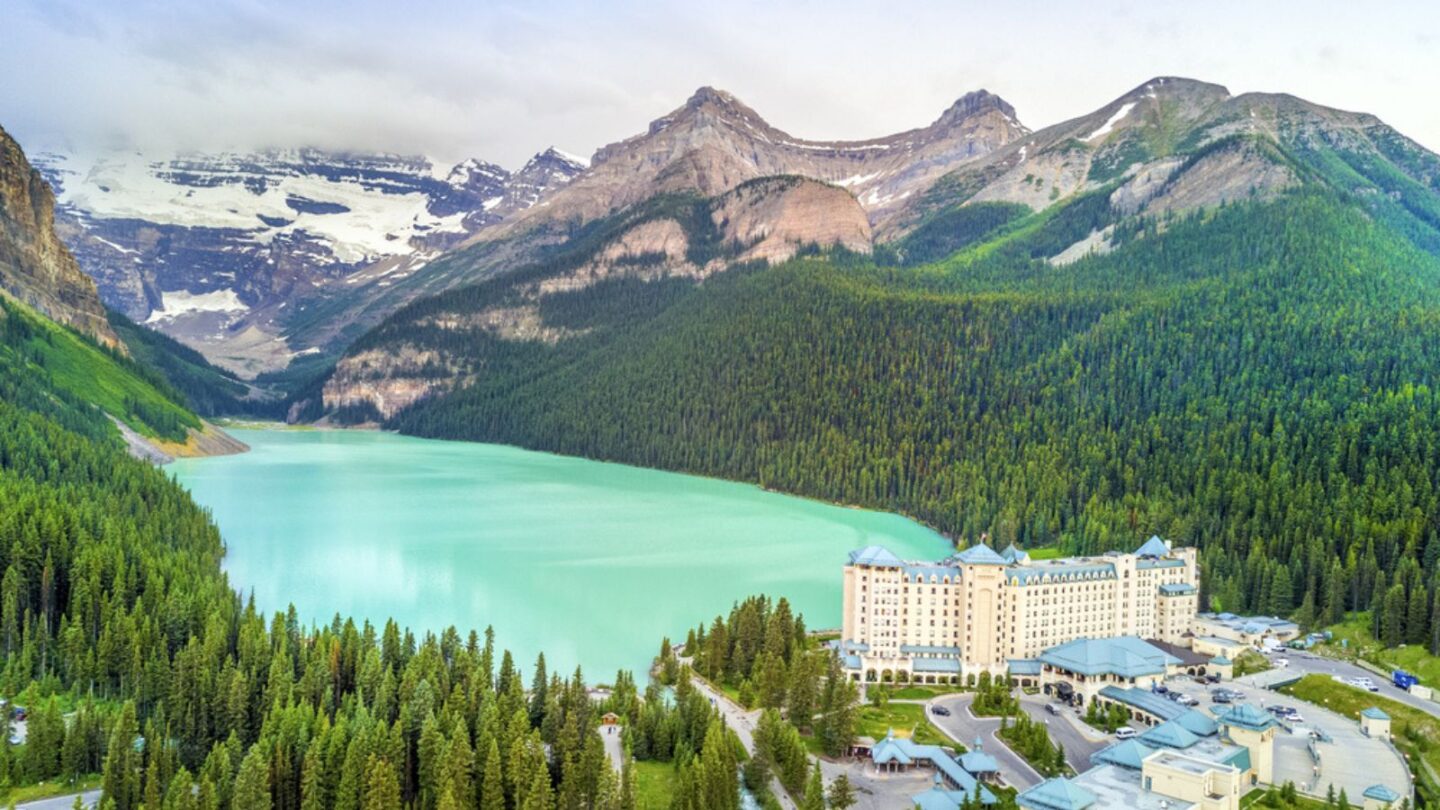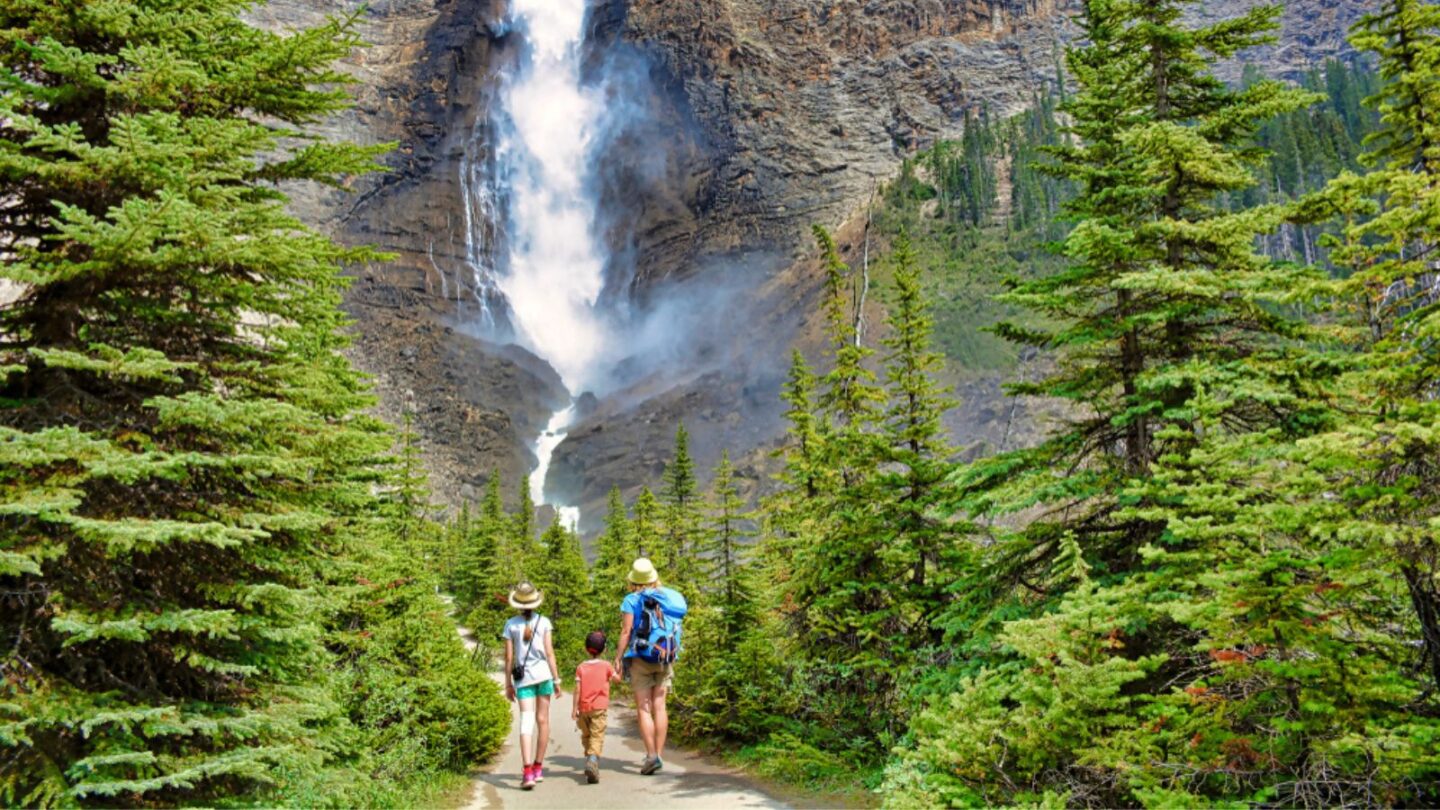Banff National Park is a bucket list destination that attracts visitors to Lake Louise and Moraine Lake. A 4-day Banff itinerary covers most must-see attractions and gives a good landscape overview. I recommend three more days in Jasper National Park, further north, if you have more time.
Flying into Calgary International Airport in Alberta provides the closest gateway to Banff. From here, you can rent a car, giving you the freedom to explore at your own pace.
It’s a 1-hour 30-minute drive on the Trans-Canada Highway to reach the town of Banff. You will need a Parks Pass or Discovery Pass to visit, which you can purchase online or at the park.
This post may include affiliate links.
When To Visit Banff?
While Banff is a year-round destination, visiting in summer allows you to see the turquoise hues of the famous lakes and enjoy good hiking weather. With the summer solstice, you’ll enjoy longer days to fill your itinerary.
July and August are the peak months for visitation. Although it’s the most crowded and expensive time, you’ll benefit from warmer weather and dry trails.
Summer comes late to the Canadian Rockies. So, if you visit Banff National Park in June, you’ll experience muddy trails, and some lakes may still be frozen. Lake Louise and Moraine Lake don’t usually thaw until mid-June.
Visiting in the fall and after Labor Day ensures fewer crowds. While you may experience changeable weather, you’ll benefit from price breaks on accommodation. Larch season provides a beautiful time for visitation, with the trees turning to shades of yellow, orange, and red.
Winter provides a contrasting visit, with frozen lakes, waterfalls, and sometimes hazardous road conditions. Should you travel in winter, rent an SUV with snow tires, pack appropriate clothing for -35C conditions, and be aware of fewer daylight hours.
Where To Stay In Banff
Banff hotels charge the highest prices and fill up fast. You can’t go wrong with a stay at the Chateau Lake Louise or Banff Springs if you’re seeking a luxury stay. Owned by the Fairmont brand, they offer pampered accommodations, in-house restaurants, and luxury spas.
You’ll find the Fairmont Banff Springs close to Bow Falls. It offers a quiet stay away from downtown, complimentary Roam bus passes, and many rooms with a view of Bow Valley.
The Fairmont Chateau Lake Louise sits on the iconic lake of the same name. If it’s the location you want, it can’t get any better than this. If you opt for a lake view room, you can even watch the magnificent sunrise without leaving your room.
The Moose Hotel and Suites is another great option. While still pricey, their suites include a kitchenette, living room, and space to sleep four – ideal for a family.
The Fox Hotel and Suites and Ptarmigan Inn offer comfortable downtown accommodations for budget-conscious travelers.
The Ptarmigan Inn includes free underground parking and a great complimentary breakfast. The breakfast buffet has a made-to-order omelet station, pastries, fruit, cereal, and many gluten-free options.
If Banff still isn’t within your budget, staying in Canmore can save you up to 50% off a stay. The downside is a 25-minute one-way drive each day to reach the town of Banff.
A 4-Day Banff Itinerary


Day One
Johnston Canyon
Start your day early and head to Johnston Canyon on the Bow Valley Parkway. Allow 30 minutes for travel time. Since this must-do route gets very busy and parking fills up quickly, hitting the trail before the crowds will provide a more enjoyable experience.
While the canyon marks two better-known waterfalls, upper and lower Johnston Falls, you’ll find a series of lesser-known ones along its waterway.
At the start of the trail, you can get coffee and a snack from “the shack.” For a quick trek, it’s a 2.3 km roundtrip journey to the Lower Falls. Expect to experience a bottleneck at the lower falls as visitors queue to get their selfies at the tiny overlook.
However, the 5.1 km route to the upper falls offers more spectacular views of a taller cascade.
Johnston Canyon sees the most tourists in summer. However, if you visit Johnston Canyon in winter, you’ll enjoy a winter wonderland with frozen waterfalls and an opportunity for ice climbing.
Bow Falls
Bow River runs through Banff and offers a chance to do river rafting. Bow Falls, sitting beneath the Fairmont Banff Springs Hotel, is the pinnacle of its route. There are two viewing points, one near the hotel and the other on the opposite side of the river.
The viewpoint off Bow Falls Avenue has the closest views and lots of paid parking. If you’re staying at Banff Springs, you can access the viewpoint on a walking trail.
From this viewpoint, you can see the river raft tours entering the river downstream from the falls.
Head back downtown and cross the Bow River Bridge to access the Surprise Corner Viewpoint. Turn right onto Buffalo Street and continue to the lookout.
Parking is limited here, but should you be able to stop, you’ll savor amazing aerial views of the falls and the Fairmont Banff Springs behind it.
Banff Hoodoos
Continue on the same roadway, which turns into Tunnel Mountain Road. After 10 minutes, you’ll reach the Hoodoos Viewpoint. Hoodoos are tall, narrow spires of rock formed by erosion. Rainwater and frost break down softer rock layers, leaving pillars.
Sometimes, as in the case of the Leanchoil Hoodoos in Yoho National Park, the pillars are topped with a large rock. As erosion continues, the pillars narrow and eventually disappear.
You can walk a trail along the ridge for different views from this viewpoint. If you feel adventurous, you can take a lengthy downhill trek to the base of the pillars for a closer look.
Banff Upper Hot Springs
End your day by having a soak in the Banff Upper Hot Springs, which is open from 10 am to 10 pm. The Banff Upper Hot Springs features an outdoor pool heated by a natural spring.
With water temperatures ranging from 37-40°C (98-104°F), you can relax and enjoy Mount Rundle’s stunning views. These mineral-rich waters are famed for their healing properties, dating back centuries.
Day Two


Day two consists of two iconic lakes, Moraine Lake and Lake Louise, which were made famous by the web.
Lake Louise
If you’re visiting in the peak months, Lake Louise’s parking area gets very busy and fills up fast. To combat the problematic parking situation, arrange a shuttle or plan to arrive early.
In the summer, guests can rent a canoe on the lake or tackle one of the many popular Banff hikes. The switchback trail to Agnes Lake allows hikers to savor a cup of tea from a mountaintop tea house. Expect the moderate return route to take over 2-1/2 hours to complete.
While remote, the tea house serves over 100 loose-leaf tea blends and bakes fresh goods daily. So, reward your climb with a slice of banana bread, a fresh cookie, or a sandwich made with homemade bread.
For experienced hikers, the longer hike to the Plain of the Six Glaciers offers a chance to dine at another tea house. Expect this out-and-back route to take 4-1/2 hours. As you climb, you’ll enjoy spectacular views of the turquoise lake and Chateau Lake Louise.
If you want to see similar views with less effort, take the Fairview Lookout trail on the other side of the lake. Not into uphill hiking? No worries. The Lakeshore trail is stroller-friendly and suitable for all ages.
You’re in for a treat if you visit Lake Louise in the winter months. While you won’t see the lake’s turquoise hues, you can enjoy a natural skating rink. Ice skating is available from mid-December onwards, and you can rent ice skates and hockey sticks from a shop in the Chateau.
Moraine Lake
Once featured on the Canadian $20 bill, visitors love Moraine Lake for its vivid blue water and backdrop of mountainous peaks.
With the permanent closure of Moraine Lake Road, visitors can only reach the lake by way of the shuttle bus. Moraine Lake is only accessible from June 1st to October, depending on weather conditions.
Like Lake Louise, Moraine Lake offers a myriad of trails and another option for canoeing. The Moraine Lake Shoreline trail offers a flat path, and you can walk to the end of the lake or complete a partial route.
The short trek to the top of the rock pile offers the best views of the lake. You’ll share the space with many others, getting their selfies here.
If you hike in this area instead of Lake Louise, be aware that some trails have frequent grizzly bear sightings. Read the sign to see if groups of four or more are recommended or mandatory. If there are under four in your hiking party, you can join others and hike together.
The trail to Consolation Lakes provides an easy route but requires some rock scrambling near the lakes. Its trail passes the Tower of Babel, popular with climbers who aim to hone their skills.
If you’re visiting the Canadian Rockies in the fall, the Larch Valley hike provides a popular route known for its autumn colors. If your timing is right, the valley’s larch trees glow in beautiful yellow tones.
After a busy day, head to Bill Peyto’s Café in Lake Louise Village. Don’t be put off by its location inside a hostel. I suggest the Angry Peyto Burger, which has a great kick with chipotle mayo and jalapeños.
Day Three
After a busy day at the lakes, relax with a leisurely day exploring areas around town.


Vermillion Lakes
If you can get up before dawn, the Vermillion Lakes provides a beautiful spot to watch the sunrise. Located close to downtown, you can often see deer and elk in the twilight hours.
With the iconic Mount Rundle as a backdrop, photographers favor Vermillion Lakes for sunrise and sunset shots.
Cave And Basin
Continue your morning at the Cave and Basin National Historic Site. While this attraction charges admission, your Discovery Pass will give you free access.
The Cave and Basin is the birthplace of National Parks in Canada. This one sits on a natural thermal spring and is thought to have healing waters.
Its interactive exhibits and outdoor pool offer insight into receding glaciers and the rare Banff Springs Snail. The highlight of a visit is the cave itself, a thermal indoor pool that emits a sulfur smell.
Outside, the Marsh Trail offers a short descending walk to the water. Here, you can appreciate the lush forest and animal life due to the waters of the natural spring.
Two Jack Lake
Northeast of Banff, Two Jack Lake provides a great summer spot for boating and paddle boarding. Surrounded by mountains, you’ll enjoy calmer waters than its neighbor, Lake Minnewanka.
If you pick up some snack food from town, you can enjoy a picnic here before continuing.
Lake Minnewanka
Visiting Lake Minnewanka allows you to view a different landscape perspective – from the water. Lake Minnewanka is the national park’s largest lake and one of the few that allows boat motors.
Book your cruise in advance to enjoy a one-hour leisurely tour on the water. While learning the area’s indigenous history, you could spot wildlife and waterfalls, too.
Sulphur Mountain Gondola
While Banff has several gondolas, the one to Sulphur Mountain offers the best views. You must purchase tickets online and reserve a time slot during peak months. Prices vary per day, with supply and demand.
Check the weather forecast and plan to go when the skies are clear. If the forecast is for bad weather on this day, swap this activity with another day.
The Sulphur Mountain Gondola opens year-round, and temperatures can be vastly different at the peak. Exiting the gondola, you can tour the two-level interactive exhibit at the presentation center and walk the 1 km boardwalk to Samson’s Peak.
To complete your day, have dinner at the Sky Bistro, which requires a reservation. With floor-to-ceiling windows, you can savor a delicious meal while enjoying the sunset over Bow Valley, Mount Rundle, and the town of Banff.
Day Four


Takakkaw Falls
As Canada’s second tallest waterfall, Takakkaw Falls takes your breath away by its sheer power. Due to an unplowed road in winter, you can only reach the falls between mid-June and mid-October, weather dependent.
To reach its parking area, you’ll need to drive on a windy road, only accessible by small vehicles. While we found the parking lot busy, the turnaround of cars was quick.
It’s a 1.3 km roundtrip walk to the falls and well worth the trek. On a hot day, the cascade provides a welcoming cool mist. Be sure to get your Instagram photos at the red Adirondack chairs.
Natural Bridge
Continue on the highway to the Natural Bridge, an unusual rock formation on the Kicking Horse River. The Natural Bridge shows a classic example of what the power of water can do to limestone.
Once a waterfall, the water eroded the landscape, creating a natural overpass. There are several viewpoints, each offering different perspectives of the bridge.
Emerald Lake
Emerald Lake is a must-visit to see its beautiful hues. Its stunning jade tones come from glacial rock flour deposited on the lake’s floor. This process is common in the Canadian Rockies’ glacial lakes, as seen at Lake Louise and Moraine Lake.
Like the lakes in Banff, you can rent a canoe or kayak on Emerald Lake. Be prepared to pay a high hourly rate, although it’s cheaper than Lake Louise.
If you prefer to enjoy the scenery, grab lunch at the Cilantro Café. The outdoor patio provides the perfect spot to savor the views in the summer.
Peyto Lake
Banff National Park has many breathtaking bodies of water, but none are as unusual in shape as Peyto Lake. Said to resemble a wolf’s head, Peyto exudes a turquoise hue in summer and freezes over in winter.
Expect the drive from Emerald Lake to Bow Summit to take one hour. The Bow Summit parking area is the highest point on the Icefields Parkway, which travels from Banff to Jasper. Due to its height, the area receives deep winter snow, making the Peyto Lake viewpoint hard to find. Should you visit in winter, snowshoes and hiking poles are highly recommended.
If you visit in summer, the area gets overcrowded with tour buses and private vehicles. Exercise some patience, as the overlook is worth the wait. The route back to Banff takes an hour.
Complete your Banff itinerary with dinner at the Block Kitchen + Bar, SALTLik Banff, or The Grizzly House. While the Block Kitchen doesn’t take reservations, its small, shared dishes are delicious and inspiring. SALTLik Banff provides the ideal locale if you prefer a steak.
However, The Grizzly House offers fondues with exotic meats. Are you brave enough to try the ostrich, rattlesnake, and alligator?
Wrap It Up
As you can see, four days in Banff National Park allows you to knock a few things off your bucket list. While your days will be busy, you’ll experience the best lakes, waterfalls, and adventures that are second to none.
Should you continue onto Jasper National Park, plan to fly into Calgary and out of Edmonton International Airport to prevent backtracking.
You’ll surely want to return after one visit to the Canadian Rockies.
Don’t forget to pin this article if you found it helpful, and follow Dukes Avenue on Pinterest for more.











